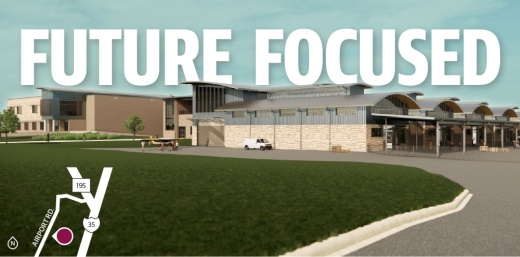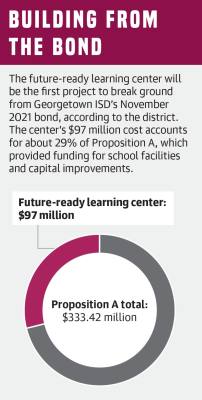The center, which will have an official name prior to opening for the 2024-25 school year, will house a number of programs and even an entire campus that aim to prepare students for their lives after GISD, according to district officials.
The upcoming complex will be home to advanced-level career and technical education, or CTE, classes; Richarte High School, the district’s academic alternative school; Bridges 18+, a program that serves students with special needs for up to four years after graduation; the early learning center; and the health and wellness center.
With 241,209 square feet of space, the new facility, located at 5001 Airport Road, will give each of the programs capacity to grow by serving more students and expanding the existing offerings.
“The primary focus of the future-ready center [is] to provide the best opportunities for our students to make sure they’re best prepared for what’s next,” GISD CTE Director Bretton Schulz said.
Customized space
Construction on the future-ready learning center is expected to begin in late summer and last two years, said Melinda Brasher, GISD executive director for communications.
Each of the leaders of the programs who will move to the center were able to provide input on the building’s design to tailor it to their needs and increase its functionally.
For the advanced CTE programs, these custom spaces include an automotive shop with eight to 10 bays, a cosmetology and barbering lab with room for 48 students to be working at once, two full-size commercial kitchens for the culinary arts program and hospital labs, Schulz said.
Additionally, the building will have an innovation space the size of three basketball courts end-to-end and a multilevel cafeteria designed to host some of the largest robotics and drone competitions in the nation, he said.
Schulz said this space will cut down on the district having to duplicate these expensive, specialized programs at each high school and allow the classes to serve more students more meaningfully.
“We were very, very intentional from the beginning on making sure that we would have a space that is flexible and would always meet the needs of whatever program we put there,” Schulz said.
Tiffani Walker, GISD executive director of special and federal programs, said the district was also able to tailor space at the future-ready learning center for the Bridges program, which helps students prepare for independent living and provides job training.
At the future-ready center, Bridges will have a mock apartment with a kitchen, living room and laundry area; grocery labs where students can practice restocking skills; and an enterprise area where students can make candles, coasters and other products. These products will then be sold out of a permanent boutique on-site.
Bridges is currently housed at the old Carver Elementary School, which was sold to Lone Star Circle of Care and the Georgetown Health Foundation that will take over the facility once the future-ready center opens.
“The layout will be significantly better,” Walker said. “It will be much more user-friendly for what our students need.”
Room to grow
The future-ready center will house Richarte High School, the district’s application-based high school that blends several nontraditional learning styles allowing students to work at an accelerated pace.
Richarte Principal Rob Dyer said due to the school’s location in a 12-classroom hallway at Georgetown High School’s North annex, it is capped at 100 students. The move to the future-ready center will double or triple the number of students who can attend Richarte, Dyer said.
With capacity for 600 CTE students at a time and the entire Richarte High School relocating, leaders said the future-ready center will alleviate some space constraints at existing high schools caused by growth in the district. Brasher said funding for GISD’s third comprehensive high school will likely be included in the next bond put before voters.
Capacity in Bridges will also more than double with the move, Walker said. She said the increased space will allow the program to admit more students who may only need one or two years of support after high school.
Walker also oversees the district’s early-learning center, a tuition-based preschool open to GISD staff and student parents. She said by moving the program, capacity will increase from 70 children to 150.
The early learning center will have flexible classroom space for children ages 0-4. Each room will have a small outdoor area and access to two indoor enclosed playscapes.
“As we as a district grow and our staff grows, that’s going to be really important that we have the capacity to be able to serve all those families,” Walker said.
Encouraging partnerships
By housing all of these varied programs under one roof, leaders said they hope each benefits from the others’ space and resources.
For example, Dyer and Walker said both Richarte and Bridges students will have increased access to CTE courses and certifications that they otherwise would not.
“Those [classes] are really important things for students—that’s their interest area and a lot of times their career path,” Dyer said.
Furthermore, Walker said Bridges students will partner with students in the culinary arts program to run a coffee shop and bistro, and Bridges students will be able to sell products from their boutique to community members coming in for services offered by the CTE classes.
“Everybody in that building will be working together for a group of kids,” Dyer said. We’ll be able to have more opportunities that way.”







